Many dogs fear going to the vet. While some are simply shy or nervous, others are truly aggressive and will growl, lunge and even try to bite. If your dog is aggressive at the vet, I have some ideas for you to try.
I’m Barbara and I write regularly for That Mutt. I’m also a blogger over at K9s Over Coffee. This post contains affiliate links.
One option, of course, is to contact a dog trainer/behaviorist who specializes in dog aggression.
However, this won’t be an overnight, quick fix. Instead, you’ll be working towards a long term solution and it’s going to cost you some money to get there.
In the meantime, there are other options you can try on your own. But before we look at those, let’s take a step back and see what can cause dog aggression at the vet’s in the first place.
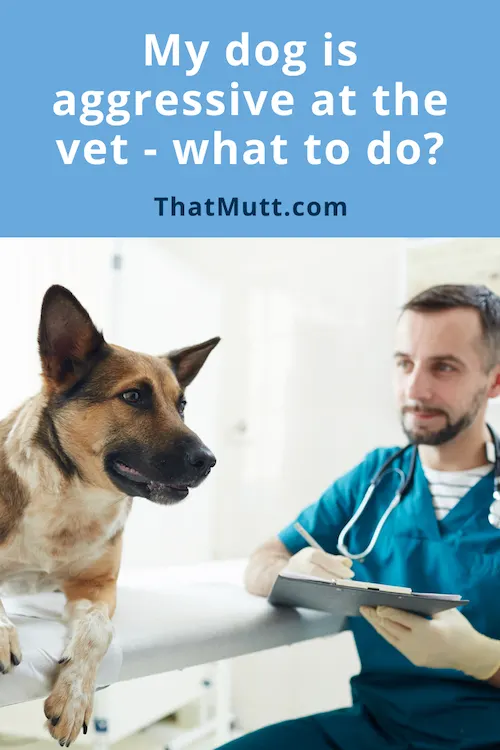
Why are some dogs aggressive at the vet?
There are several reasons why some dogs are aggressive at the vet, and they’re going to vary from one individual dog to the next.
Also, keep in mind that sometimes we just don’t know why a dog is aggressive at the vet or acts the way she does.
Some dogs weren’t properly socialized to new places and other dogs/pets. As a result, they will fear these sudden experiences when they do happen, such as when they’re going to the vet’s.
Lindsay, the owner of this blog, has a weimaraner named Remy who gets scared and nips while at the vet. Remy came from a great breeder and has had plenty of socialization. He is generally an enthusiastic, friendly guy, even when he goes to the vet.
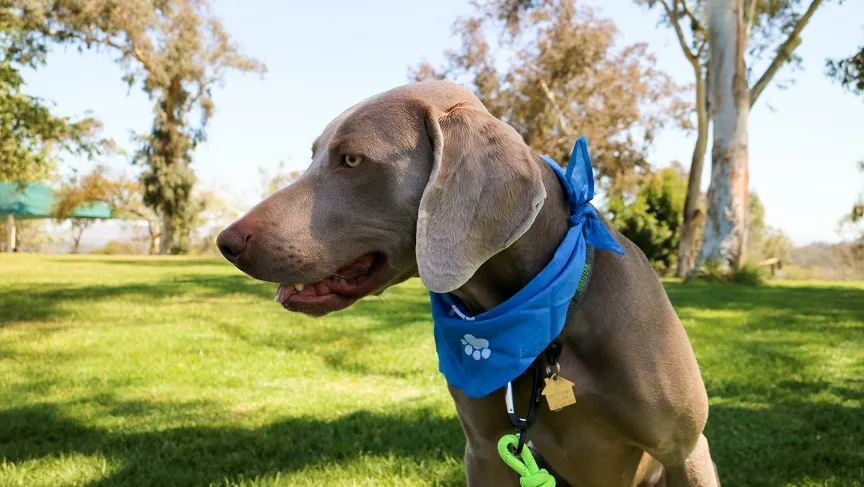
However, once the vet starts to handle him, Remy gets nervous and will sometimes try to bite. He requires a muzzle at the vet and anxiety medication.
Lindsay could’ve done a better job getting Remy used to basic vet exams as a puppy. At the time, she thought she had done a good job, but you can never do enough socializing your puppy to being handled by different people.
Fearful dogs react in different ways. Some freeze or tuck their tail, others are more “outgoing” and will show aggression along with potential biting.
Here are some socialization tips:
Introduce your dog to as many people, animals, objects, sounds and places as possible. Do so in a safe, slow way at the dog’s own pace. Essentially anything that he might ever encounter, such as:
- A crying baby
- Tall men with baseball hats
- The sound of the vacuum cleaner and the door bell
- Riding in a car
- Having feet, paws, ears and nose touched
- Going into a store or the vet’s – you get the idea.
Here is our list of socialization tips for dogs and puppies to help you brainstorm more ideas.
2. The dog had a bad experience at the vet
Some dogs have simply had a bad experience during a vet visit that pops back up in their memory when they re-encounter their trigger.
This could be a specific person who handled them roughly, like a receptionist, vet tech, or even the vet himself. Maybe it’s just going to be the vet’s white coat that will trigger a bad memory.
Or maybe the dog was bitten by a large red dog in the waiting area, or he fell off the exam table and hurt himself. Now whenever he sees a large red dog or an exam table, he’s going to want nothing to do with either.

Again, sometimes you just won’t know why your dog is afraid at the vet, especially if you adopted your dog and don’t know his history.
*Enjoying this article? Get realistic dog training tips emailed once a week. Click Here
3. The dog’s owner is nervous
Dogs are very receptive of their humans’ feelings, and tend to mirror their energy. Imagine an overly nervous owner who’s terrified about the impending vet visit. That’s because they fear that something may happen to their dog or because of their dog’s behavior.
Consequently, that nervousness is going to manifest itself in the way they’re clenching the dog’s carrier or holding the dog’s leash (with tension). It’ll transfer right onto their dog, and guess what!? The pup is also going to show her nervousness, but how she displays it depends on her overall personality.
If the dog is shy, she may freeze or urinate, but if she’s more assertive, she may very well become aggressive and bite.
4. The dog is reactive to other dogs
Some dogs are reactive to other dogs. That means that they’re not comfortable being in close proximity to other (usually leashed) dogs, which is often the case in full waiting rooms at the vet’s.
If your dog is aggressive at the vet, talk to your vet in advance on what to do
Having explained all that, it’s a lot better to be proactive than to hold your breath and hope for the best. That’s why it’s a good idea to contact your vet in advance of your appointment. Let her know that your dog is aggressive at the vet, and ask for her advice.
Your vet has probably had to deal with aggressive dog patients more times than she can count and has found solutions for the problem.
For example, she may ask you to come in through the back door or schedule an appointment when they’re not as busy.
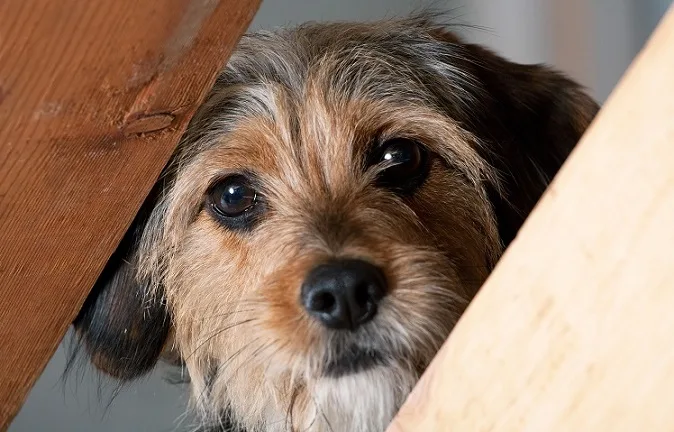
As I said earlier, Lindsay gives her dog Remy anti anxiety medication before taking him to the vet. The vet techs also know to put a muzzle on him before his exam.
Luckily he’s a super friendly guy and doesn’t have any issue with them putting the muzzle on. It’s just the actual exam that makes him nervous.
Lindsay’s cat Scout is also very aggressive at the vet, so Scout takes same anxiety medication before his visits! I’ve written more info about cats below.
Be honest about your dog’s issues
When you contact your vet, let her know what exactly triggers your dog. Is it only other dogs? Just cats? Other pets in general? Tall men with hats? Being handled by strangers? Does your pup only act up when the vet staff takes him behind the scenes and your dog is separated from you?
Once the vet knows what your dog is uncomfortable with, it’ll be easier for her and her staff to work around those issues.
For example, in Lindsay’s case, her dog is super friendly right up until the actual exam begins.
Medications/sedation as an option, ask the vet
When you’re talking to your vet about your dog’s issues pre-appointment, see about asking him for medications that might make him calmer. A lot of the anti-anxiety medications recommended for use at the vet are the same medications for dogs during fireworks or travel.
For extreme cases of aggression, sedation may be the only way for the vet to see your pup. Don’t be ashamed if this is the case. You have to do what is best for your pet.
Dog appeasing pheromones – Adaptil
Dog appeasing pheromones are a much less invasive (and less expensive!) option than medications or sedation, so it might be worth a shot trying them. Pheromones are chemicals produced by animals that work outside the body and can affect behavior.
Adaptil is a pheromone-based product for stressed and fearful dogs that can be purchased online at Chewy or elsewhere. It’s available as a on-the-go collar, spray, and diffuser.
Be calm yourself – it’s not personal, try not to be upset or embarrassed
It’s also helpful when you, the human, are calm before, during, and after the vet visit. Remember, dogs and cats pick up on our energy and feelings and tend to mirror them.
Of course that’s easier said than done, but try incorporating some of the following techniques and tools to help you be calm:
Exercise your dog before the vet visit.
You could take him for a walk or play some fetch with him. Obviously that won’t be possible if you’re seeing the vet because of a broken limb or similar health issue, but exercise reduces stress hormones and elevates our mood!
Walk your dog on a short leash.
Short leashes give you more control when you’re in a high traffic environment like at the vet’s. That’s because your dog is “forced” to stay right next to you and doesn’t have any opportunity to wander off and bother other pets.
And when you feel like you’re in control, you’ll automatically be more calm!
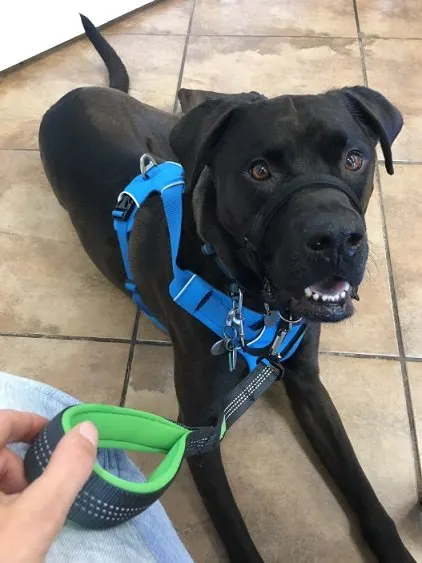
Muzzle your aggressive dog at the vet.
When your dog is muzzled, you know he won’t be able to bite. That’s peace of mind for you which will make you feel more confident and calmer about his behavior. A simple fabric muzzle may work for your dog, and it’s what a lot of vets have on hand.
Muzzle training a dog
A muzzle provides peace of mind because you know your dog won’t be able to bite. Ideally, you’ll want your dog to be comfortable wearing a muzzle when you need to put it on at the vet’s, or rather before you walk him into your vet’s.
If you only put it on him for vet visits, he’s likely going to associate the stressful vet visit with it. That’s probably going to result in him putting up a fight when you’re trying to put it on him.
That’s why it makes sense to get your pup used to wearing a muzzle prior to vet visits.
See That Mutt’s article How to Get Your Dog Used To A Muzzle – 6 Steps for more information on muzzling your dog. We believe all dogs should be comfortable wearing a muzzle because you never know when your dog might require one due to an emergency.
Wait in your car until your appointment
If you’d rather avoid the waiting room area altogether, you can just wait in your car until your appointment. Simply call the vet to let them know you’re there and that you’d be more comfortable if they could let you know when they’re ready for you.
There shouldn’t be any reason for the receptionists or vet techs to decline your request.
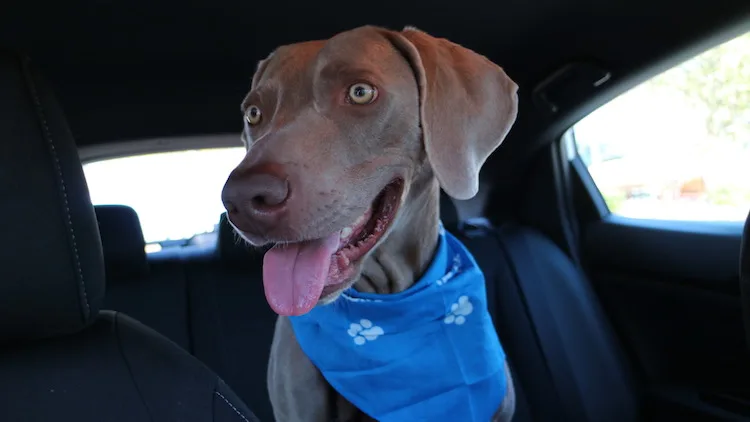
Try to go to the vet when it’s quiet – 1st or last appointment
Another option is to ask for an appointment when it’s less busy. This will usually be the case first thing in the morning or towards the vet’s closing time. Or possibly on a weekend, depending on that particular vet clinic’s typical schedule.
Try to avoid Mondays as they’re typically very busy.
Make the vet office a positive experience
Consider this out-of-the-box approach! Don’t just take your dog to the vet for exams or whenever he’s having a procedure done. Instead, take him for a fun ride to where your vet is located, then go for a walk in that neighborhood if possible.
On your way back to your car, see about popping into the reception area just long enough to get your dog a friendly pat from a receptionist along with a treat – vets always have treats!
Do this on a regular, maybe bi-monthly basis, and your dog should start to make a positive association with his vet’s office building. Walks, treats, and TLC, yay!
I would probably ask the vet ahead of time if they’re ok with this approach, but my guess would be that most vets will be willing to work with you and your pup.
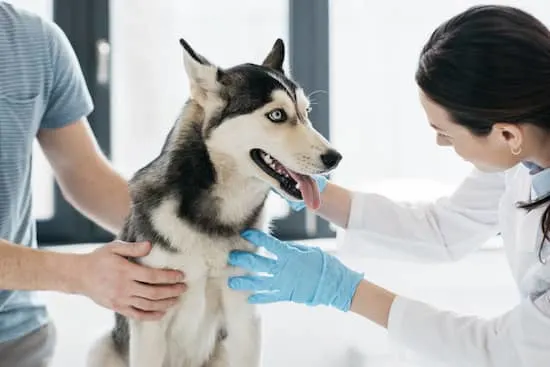
After all, they should be interested in providing positive experiences for all of their pet clients and their paying humans.
Find a new vet if your current vet seems annoyed or not accommodating
If your current vet doesn’t want to work with you and your pup and seems annoyed, find a new vet if possible. Unless you’re in a small town or rural area, hopefully you have several vets to choose from.
Lindsay actually switched vets because the first vet was very annoyed by Remy’s behavior. Yes, Remy is very naughty at the vet but it’s the vet’s job to accommodate their clients or try to suggest a solution like anxiety medication or a muzzle.
Remy’s new vet is great with him and is very willing to work around his “quirks.” It’s a much better experience for everyone.
Your new vet will be able to call your old vet and get all your dog’s medical history transferred over.
Try VetLocator.com to find a vet near you.
Consider having the vet come to you if that’s an option
Another option is to have your vet come to your home. Some regular vets offer house calls in addition to their regular office hours, but there are also vets who specialize in house calls only.
They’re typically known as mobile vets or house call vets and will come to your home in a van with a mobile clinic. Similar to mobile groomers who come to people’s homes!
Try VetLocator.com to find a house call vet near you.
Thank the vet and staff for their patience with your dog
Here’s something else to consider. Yes, vets have to deal with a variety of dog patients (and their owners!), and some of them are inevitably going to be a handful. However, their patience and additional work these dogs require deserve to be acknowledged.
So if your pup falls into that category and has aggressive tendencies that require extra work on the vet’s part, thank them and their staff for their patience. You could write them a personal thank you note and mail it to the vet’s office.
Or how about saying thanks for an extra difficult case with coffee and cookies for the staff? You’re guaranteed to bring smiles to all the hard working people at the vet’s!
What happens if my dog bites the vet?

Vets typically consider dog bites an occupational hazard and are highly unlikely to sue you if your dog bites them. That’s especially true if you were proactive and contacted the vet about your dog’s fear of vet visits.
What about aggressive cats at the vet?
Many of the tips above can be slightly modified and used for aggressive cats as well, such as:
- Take your cat to the vet without an actual appointment. Call the vet’s office ahead of time and let them know you’re working on desensitizing your cat to the dreaded vet visit. This is just about getting your cat some TLC from the staff along with some treats.
- Get the cat used to her carrier before you use it to take her to the vet. This is similar to the muzzle approach with dogs. If you only pull it out for impending vet visits, she’s going to start making the (negative) connection. Instead, set it up in your home and turn it into a hangout spot your cat will be drawn to! You could put cat scratcher cardboard in there, along with a favorite toy and/or food.
- Use a cat calming spray like Feliway. Spray it directly onto your cat, the carrier, and/or your car.
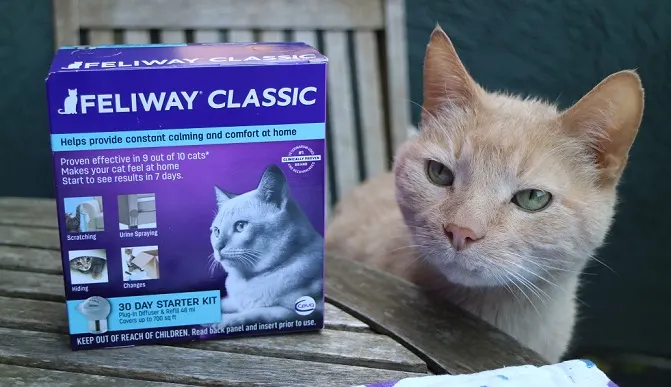
- Calming medications. If Feliway doesn’t work for you cat, contact your vet before an appointment and talk to them about calming medications for your anxious cat.
- Ask for an appointment when it’s less busy. Your cat will likely be less stressed if no (loud) dogs are waiting in the waiting room area.
- Cover your cat’s carrier with a blanket or towel. If you can’t get in during a slow time of the day, it’ll make her feel safer once you’re in a busy waiting area.
- Wait in the car until your appointment. Another option is to simply wait in the car until it’s your turn, then walk straight into your exam room.
- Vet home visits. See if your regular vet offers home visits. If they don’t, try to find a vet who does.
Now we’d like to hear from you!
Now it’s your turn! If your dog is aggressive at the vet, have you used any of these approaches? Do you have any additional advice for someone else whose dog is aggressive at the vet?
If you have any questions, let us know in the comments!
*Enjoying this article? Get realistic dog training tips emailed once a week. Click Here
Barbara Rivers writes regularly for That Mutt. She is certified in raw dog food nutrition from Dogs Naturally Magazine and the author of three ebooks about balanced raw dog food. She is a blogger at K9s Over Coffee.
